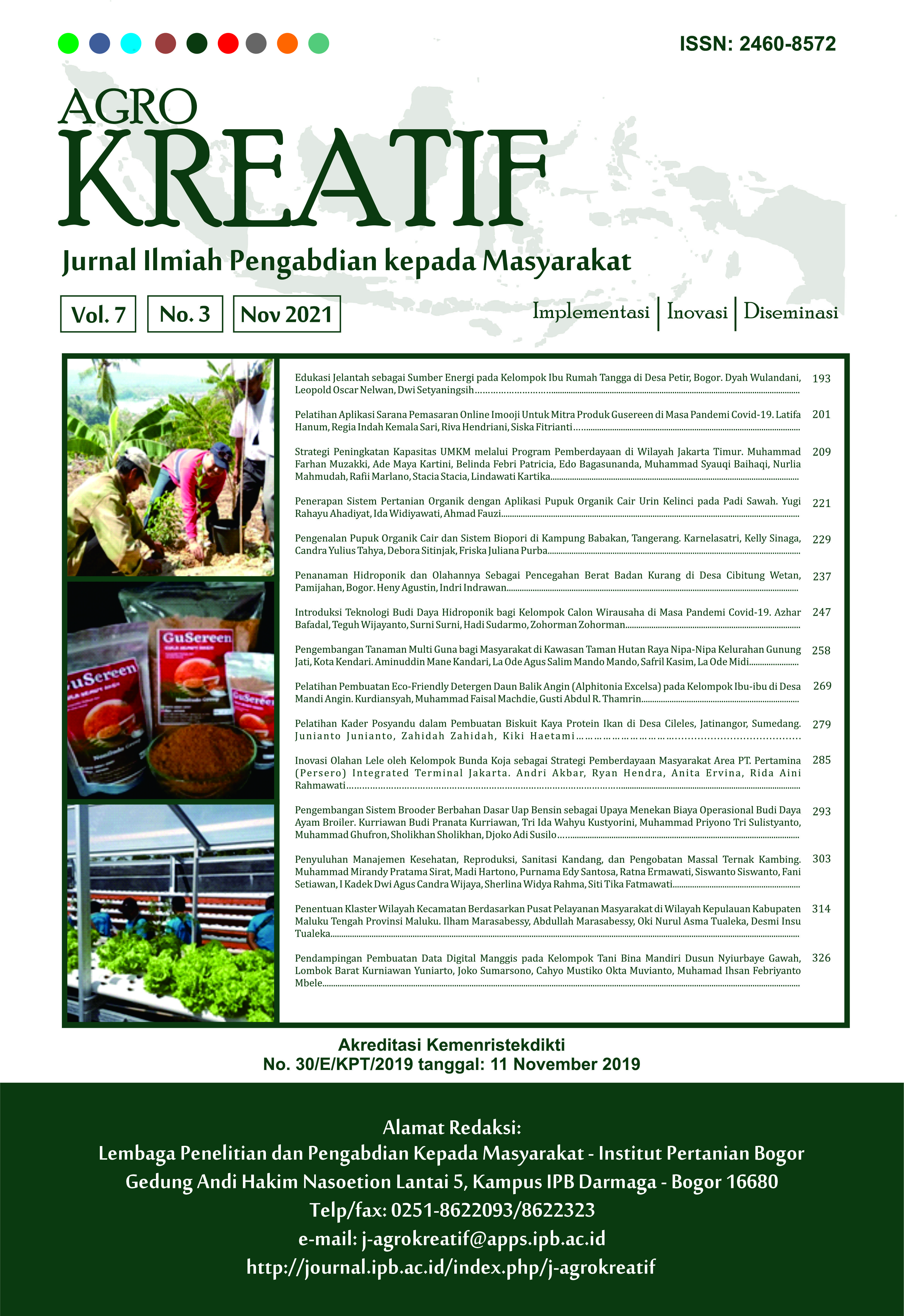Inovasi Olahan Lele oleh Kelompok Bunda Koja sebagai Strategi Pemberdayaan Masyarakat Area PT. Pertamina (Persero) Integrated Terminal Jakarta
Abstract
Knowledge about food nutrition for toddlers and the ability to buy nutritious food are important factors in toddlers parenting. Kelurahan Rawa Badak Selatan (KRBS) is one of area in Koja Subdistrict, North Jakarta which dominated by toddlers whose nutritional status needs to be improved. CSR PT. Pertamina Integrated Terminal Jakarta carried out the Serba Unsur Lele (SULE) program as a community empowerment strategy by create various product innovations from catfish and catfish bone by-product. The aim of this activities is Bunda Koja community, including mothers of toddlers, are able to improve the knowledge and skills of catfish products processing and build a growing business, some products that routinely given to toddlers are expected to give a positive impact for toddler nutrition. This program consisted of training and the application of mentoring. The series of programs include training on catfish products innovation training, management of catfish production, and product marketing. The innovations been developed for production is nuggets, abon, and catfish stick. Catfish bones by- product are processed into crackers, tempe chips, and fish bone biscuits. Abon, nuggets, crackers and tempeh chips have been through the production and marketing stages. This activity succeeded in having a positive impact especially for mothers of toddlers, could receive the additional income from the catfish product business. The more catfish products innovation which will be developed is expected to become a business so that it can have a positive impact on the economy of the Bunda Koja community, mothers of toddlers, and the surrounding community.
Downloads
References
Bechtel PJ, Watson MA, Lea JM, Bett-Garber KL, Bland JM. 2015. Properties of bone from catfish heads and frames. Food Science and Nutrition. 7(4): 1396–1405. https://doi.org/10.1002/fsn3.974
Handayani DIW, Kartikawati D. 2015. Stik lele alternatif diversifikasi olahan lele (Clarias sp.) tanpa limbah berkalsium tinggi. Jurnal Ilmiah. 4(1): 109–117.
[Kemenkes] Kementrian Kesehatan RI. 2018. Riset Kesehatan Dasar Tahun 2018.
[Kemenkes] Kementrian Kesehatan RI. 2013. Peraturan Menteri Kesehatan Republik Indonesia Tentang Angka Kecukupan Gizi Yang Dianjurkan Bagi Bangsa Indonesia Nomor 75 Tahun 2013.
Ningsih S, Kristiawati, Krisnana I. 2014. Hubungan perilaku ibu dengan status gizi kurang anak usia toddler. Jurnal Pediomaternal. 3(1): 58–65.
Rahma AC, Nadhiroh SR. 2016. Perbedaan sosial ekonomi dan pengetahuan gizi ibu balita gizi kurang dan gizi normal. Media Gizi Indonesia. 11(1): 55–60. https://doi.org/10.20473/mgi.v11i1.55-60
Riyadi H, Khomsan A, Dadang S, Faisal A, Eddy S. 2006. Studi tentang status gizi pada rumah tangga miskin dan tidak miskin. Gizi Indonesia. 1(2006). https://doi.org/10.25182/jgp.2006.1.1.23-28
Tan AN. 2020. Strategi Penguatan Modal Sosial dalam Pelaksanaan Program CSR−Serba Unsur Lele. [Skripsi]. Bogor (ID): Institut Pertanian Bogor.
Ulfa. 2018. Makalah Tenaga Kesehatan Kota Administrasi Jakarta Utara Tahun 2018.
Zulisyanto D, Riyadi PH, Amalia U. 2016. Pengaruh lama pengukusan adonan terhadap kualitas fisik dan kimia kerupuk ikan lele dumbo (Clarias gariepinus). Jurnal Pengetahuan dan Bioteknologi Hasil Perikanan. 5(4): 26–33
This work is licensed under a Creative Commons Attribution-NonCommercial 4.0 International License.



















